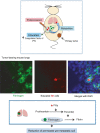Regulation of vascular permeability in cancer metastasis
- PMID: 33966313
- PMCID: PMC8353911
- DOI: 10.1111/cas.14942
Regulation of vascular permeability in cancer metastasis
Abstract
Enhancement of vascular permeability is indispensable for cancer metastasis. Weakened endothelial barrier function enhances vascular permeability. Circulating tumor cells moving in the microvasculature tend to invade into stromal tissue at the location where vascular permeability is enhanced. Many basic studies have identified permeability factors by using gene-modified animals and cells. These factors directly/indirectly interact with endothelial cells. Here, we review vascular permeability factors and their molecular mechanisms. Interactions between tumor cells and endothelial cells are also discussed in the process of extravasation, one of the most critical steps in tumor metastasis. In some cases, primary tumors can manipulate permeability in a remote organ by secreting permeability factors. In addition, the importance of glycocalyx, which covers the endothelial cell surface, in controlling vascular permeability and tumor metastasis is also described. Furthermore, analysis of the hyperpermeable region found in a mouse model study is introduced. It clearly showed that tumor-bearing mouse lungs had a hyperpermeable region due to the influence of a remote primary tumor, and fibrinogen deposition was observed in that region. Given that fibrinogen was reported to be a permeability factor and a key regulator of inflammation, eliminating fibrinogen deposition may prevent future metastasis.
Keywords: endothelial cell; fibrinogen; metastasis; permeability; premetastatic soil.
© 2021 The Authors. Cancer Science published by John Wiley & Sons Australia, Ltd on behalf of Japanese Cancer Association.
Conflict of interest statement
The authors have no conflict of interest.
Figures



References
-
- Hüsemann Y, Geigl JB, Schubert F, et al. Systemic spread is an early step in breast cancer. Cancer Cell. 2008;13(1):58‐68. - PubMed
Publication types
MeSH terms
Substances
LinkOut - more resources
Full Text Sources
Other Literature Sources
Medical

